| Home | Nature Weekly Index |
12 October 2014 | Broadleaf Maidenhair Fern (Adiantum latifolium) |
.jpg)
.jpg)
.jpg) I first saw this lone young fern growing at the foot of the much larger
Thinleaf Brake (Pteris biaurita fern in my pot in November 2012. It was hard to
determine the identity of this young fern at that stage as it had just a few leaves (fronds). I was hoping that it might turn out to
be something rare or exotic, like the Thinleaf Brake fern. The few Thinleaf Brake ferns that reside in this pot were considered
rare in Singapore. It is not available in the wild here. The colony developed from spores that came with the horticulture soil. As
for the lone young fern, it is definitely not the juvenile form of the Thinleaf Brake fern.
I first saw this lone young fern growing at the foot of the much larger
Thinleaf Brake (Pteris biaurita fern in my pot in November 2012. It was hard to
determine the identity of this young fern at that stage as it had just a few leaves (fronds). I was hoping that it might turn out to
be something rare or exotic, like the Thinleaf Brake fern. The few Thinleaf Brake ferns that reside in this pot were considered
rare in Singapore. It is not available in the wild here. The colony developed from spores that came with the horticulture soil. As
for the lone young fern, it is definitely not the juvenile form of the Thinleaf Brake fern.
Due to the dominance of the larger fern, the young fern grew very slowly. Over 5 months, there was not much progress (middle picture). By August 2013, the identity of the fern started to unveil --- it was a Broadleaf Maidenhair (Adiantum latifolium); a rather common fern in the wild here. It is abundant in the park near my place. The pores that produced this young fern had probably travel via air current and landed in the pot.
As the dominant fern eventually succumb to old age in early 2014, the colony of Broadleaf Maidenhair started to proliferate in strength and occupied a corner of its own. It appeared to thrive well under shade. For ornamental purpose, it is a neat and nice looking fern to have in the pot. The first 2 pictures below (from the left) were the colony from my pot while the rest were seen in the wild. So far, the fern in my pot had yet to produce any spores.
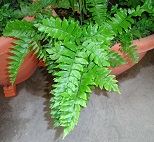
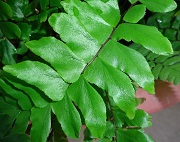
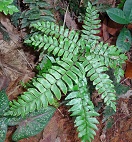
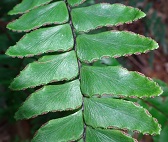
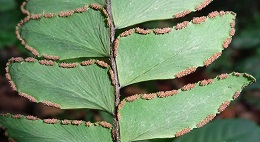
I did eventually get an exotic fern as the Broadleaf Maidenhair was reported to be originated from South America. With the decease of the Thinleaf Brake fern, another dominant fern has took over its position gradually. It is the Cyclosorus subpubescens that I had written a short note back in March 2014. Despite the towering Cyclosorus subpubescens, the Broadleaf Maidenhair did not show any distress.
In the same pot was a tall Andrographis paniculata (King of Bitters) and at least 2 Clidemia hirta (Hairy Clidemia). All the plants were not planted intentionally but was the results of competitive ecological development over a tiny piece of land.